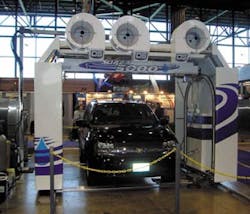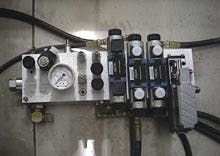Car washes used to be considered eyesores and were often tucked away behind large department stores. With little emphasis placed on marketability, the car wash equipment industry of the time was largely influenced by price — a deciding factor that would quickly change with equipment technology. Capitalizing on new innovations in touchless car wash technology, D&S Mfg. Inc., a manufacturer of stainless steel car wash equipment, introduced the D&S 5000 high-pressure touchless, brushless automatic car wash — ushering in the next generation of car wash system designs.
When it was first introduced in 1991, the 5000 was powered by a double pump hydraulic system. The system's main pump was rated for 5.5 gpm, and a smaller one for 1.1. Component selection, as in most equipment purchases, was driven largely by price. As business owners began to realize the potential profitability of the car wash, they strove toward faster wash cycles and a better quality wash. In response, D&S embarked on a redesign of the 5000 and contacted its fluid power partner, John Henry Foster Co. (JHF), a St. Louis-area fluid power distributor.
After reviewing the application criteria, JHF encouraged D&S to allow them to redesign the entire hydraulic system using hydraulic components from Bosch Rexroth's Industrial Hydraulics Div. Even though D&S could manufacture and assemble its own systems, they agreed, and JHF was on its way from being a small parts supplier to a complete systems solution provider.
"Our goal has always been to help each car wash owner build a successful operation and achieve the maximum potential return on their investment," said Dave Benedict, D&S CEO. "Our cooperative efforts with John Henry Foster Co. allowed us to incorporate higher quality components, resulting in better overall system performance — all while staying within our cost parameters."
Manifold cleans up design
Ted Cassimatis, Phil Green, and Ken Strain, members of the JHF sales and engineering team and contributors to the D&S 5000 redesign, described the original hydraulic system as a double pump mounted on a vertical tank and driven by a 7½ hp motor. A three-station, size D03 manifold with standard directional valves and sandwiches routed fluid to control the speed of the machine's main U-shaped gantry, plus a side spinner motor, and an oscillator motor. When a vehicle entered the car wash, it actuated a switch on a tire treadle, prompting the gantry to pass over the vehicle. The gantry applied presoak as it moved over the top of the vehicle, and a hydraulic motor drove oscillators during the entire cycle.
When the gantry reached the end of a vehicle, and proceeded down the front or back, its descent speed was reduced, and a counterbalance valve prevented the load from over-running. At the bottom of the descent, an electronic eye signaled the gantry reverse its direction. The gantry passed over the vehicle, applying high-pressure wash, spot free rinse, and optional chemicals according to the wash package selected.
Polishing up the design
"When we reviewed the original system design we quickly uncovered several issues that we knew we could remedy," recalled Cassimatis, who cited several examples. The team noted that the machine ran hot, and the gantry's hydraulic motor sometimes would stall when heat was extreme. The oscillators only needed flow of 0.6 gpm, but were fed by a dedicated gear pump rated for 1.1 gpm. In addition, D&S wanted more speed on the main gantry without increasing energy consumption of the machine.
To solve these challenges, the JHF team proposed using a 7½-hp electric motor powering a 6.5-gpm Rexroth gear pump supplying a two-station, size D03 manifold. A small, custom block on the first manifold station houses a priority flow control valve (0.6 gpm with ±25% tuning adjustment) for the oscillators, with the balance of the flow going to the main gantry. A common relief valve for both circuit legs was also incorporated.
The second station provides hydraulic fluid to the main gantry via a Rexroth DO3 standard directional valve, and a kick-down relief valve reduces pressure as the gantry reaches to the bottom of its stroke. JHF observed that the unit actually slowed to an ideal speed with the kick-down relief, eliminating the need for a third station that was needed solely for low-speed actuation.
"The redesigned D&S 5000 is faster, simpler, higher quality and more reliable," summarized Benedict. He also noted that labor to assemble the system placed it soundly within the required price range.
Even faster and cleaner
As demand in the privately owned car wash market grew, D&S decided to design a new touchless system specifically for the convenience store and fuel station market. The D&S Super 5000 car wash boasts even faster cycle times and higher quality washes. The Super 5000 can also size up a vehicle and travel only the distance required.
This gives a better wash on the rear of shorter cars and shortens the entire cycle time, which increases the number of cars that can be washed per day. D&S also included remotely adjustable variable speeds for each individual pass of the car, giving the system the ability to adjust its speed depending on the chemical that is being applied to the car — an adjustment that provides an even better overall wash.
When the JHF team evaluated D&S's wish-list of variable speeds and cycle times for the new Super 5000, ramping capabilities were incorporated to give smooth acceleration and deceleration for the carriage and gantry movements. Given a high inertial non-overrunning load and only one function operating at a time, JHF chose a system driven by a Rexroth gear pump and a proportional throttle valve for bleed-off speed control of the carriage and gantry. The proportional valve allows the Super 5000 to attain higher speeds without abrupt starts and stops and provides an infinite number of speeds for presoak, high-pressure wash, spot free rinse, and optional chemicals.
"The Rexroth proportional throttle valve was really the key to the Super 5000 project," said Cassimatis. "It made the infinite number of speeds possible, while keeping the system simple with only one proportional valve to control both the carriage and the gantry functions. Car wash owners can adjust each pass to their own preference for the ultimate in speed and flexibility."
Other fixed-speed functions — side spinners, oscillators, and optional side blasters — are fed by a priority flow-control valve, and each function has manual independent speed control. These features, as well as other new engineering changes, reduced the cycle time by up to 30%, depending on the size of the vehicle.
JHF also designed a custom manifold to incorporate all valving and organize the system piping with fewer connections, fewer potential leak points, and easier access — all in a smaller, lighter package.
For more information, contact John Henry Foster Co. at (314) 427-0600, or visit the website at www.jhf.com.




